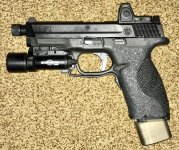Somehow my last post on this subject was deleted and to be blunt I'm getting tired of repeating myself so I hope the moderators will let this one stay.
To directly address the OP, you're presenting an extremely limited situation, strict home defense. You listed some advantages of being in a static, know defensive position and under those extremely limited parameters you would be at LESS of a disadvantage compared to someone with a weapon mounted light, WML.
So in other words when it comes to time shoot, and lets face it the entire dance, meaning all of the strategies and tactics are useless unless the person performing them can not get rounds on target, then there is NO FASTER AND MORE ACCURATE WAY TO ACHIEVE HITS IN LOW LIGHT SITUATIONS THEN A WML.
This is not opinion, this is fact. Any shooting at night/under limited lighting is faster and more accurate with a WML. Be it handgun, shotgun or rifle, and I've shot all three under low light/no light situations, any other technique is a compromise at best.
For the sake of this post lets just stick to handguns. The biggest misperception when discussing WML on the handgun is most people frame the debate at EITHER WML or hand held light. The correct response is BOTH. Some situations will require just a light and some situations will require a light and gun. Having both tools available will hopefully prevent the misuse of either.
Using a handheld light is tricky and learning to do it right is time consuming. In my time, 10 years with the Marines and 27 years in LE, 20 of those as a firearms and tactics instructor, I've been exposed to most of the common gun/light techniques. Namely:
FBI technique. Sometimes jokingly called the Statue of Liberty technique. Basically gun is held in one hand the light is held in the other, as high and far away from the body as possible. The thought being the bad guys will shoot back at the light.
Modified FBI technique, sometimes called he turret. As bigger and heavy lights became the norm for LE and security the FBI technique was modified. The gun is still held one handed but the light is rested on the support side shoulder. The shooter moves their entire body, like a tank's turret, to face the threat.
Please note the FBI and modified FBI both are really the ONLY techniques where the gun is held solely in one hand. Both can be used with lights using side switches, such as Mag Lights, and end switches, such as Surefires.
Harries Technique. Taught by many LE agencies. An adaptation of the Weaver technique. Instead of front/back isometric tension you have side to side tension. The gun is thrust forward and the light is brought UNDER the gun so the two hands are back to back. Can be used with all types of lights.
Chapman technique. The support hand forms the "OK" sign. The light is held between the thumb, which controls the switch, and the first finger. The other three are used to grip the handgun. Limited to those lights using a side switch.
Ayoob technique, developed and taught by Massad Ayoob. Light is FIRM held in support hand with all fingers on light and thumb controlling switch. Base of both thumbs are firmly pressed together as light and gun, as one unit, are thrust forward. Again limited to lights using a side switch.
Wilson/Surefire technique. The light is held "cigar" style is the support hand, with a large "O" ring attached to the middle and outside the fingers. The support hand assists the primary and in controlling the weapon. Tightening one's grip presses the rear switch inward controlling the light. Limited to Smaller lights with rear switches and middle rings. For some time the FBI issued Surefire Z2 lights to its agents just for this technique.
ALL of these techniques to some degree or another limited how much the support hand can assist in controlling the weapon. Using a WML completely eliminates that limit. Well thought out lights allow a completely normal two handed grip on the weapon.



